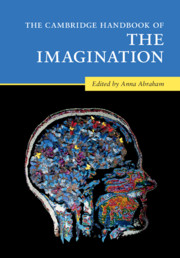Book contents
- The Cambridge Handbook of the Imagination
- The Cambridge Handbook of the Imagination
- Copyright page
- Dedication
- Contents
- Figures
- Contributors
- Acknowledgments
- 1 Surveying the Imagination Landscape
- Part I Theoretical Perspectives on the Imagination
- Part II Imagery-Based Forms of the Imagination
- Part III Intentionality-Based Forms of the Imagination
- Part IV Novel Combinatorial Forms of the Imagination
- Part V Phenomenology-Based Forms of the Imagination
- 34 Imagination in the Philosophy of Art
- 35 Imagination in Aesthetic Experience
- 36 The Arts and Human Symbolic Cognition: Art is for Social Communication
- 37 Aesthetic Engagement: Lessons from Art History, Neuroscience, and Society
- 38 Dance and the Imagination: Be a Butterfly!
- 39 Imagination, Intersubjectivity, and a Musical Therapeutic Process: A Personal Narrative
- Part VI Altered States of the Imagination
- Name Index
- Subject Index
- References
37 - Aesthetic Engagement: Lessons from Art History, Neuroscience, and Society
from Part V - Phenomenology-Based Forms of the Imagination
Published online by Cambridge University Press: 26 May 2020
- The Cambridge Handbook of the Imagination
- The Cambridge Handbook of the Imagination
- Copyright page
- Dedication
- Contents
- Figures
- Contributors
- Acknowledgments
- 1 Surveying the Imagination Landscape
- Part I Theoretical Perspectives on the Imagination
- Part II Imagery-Based Forms of the Imagination
- Part III Intentionality-Based Forms of the Imagination
- Part IV Novel Combinatorial Forms of the Imagination
- Part V Phenomenology-Based Forms of the Imagination
- 34 Imagination in the Philosophy of Art
- 35 Imagination in Aesthetic Experience
- 36 The Arts and Human Symbolic Cognition: Art is for Social Communication
- 37 Aesthetic Engagement: Lessons from Art History, Neuroscience, and Society
- 38 Dance and the Imagination: Be a Butterfly!
- 39 Imagination, Intersubjectivity, and a Musical Therapeutic Process: A Personal Narrative
- Part VI Altered States of the Imagination
- Name Index
- Subject Index
- References
Summary
In its emphasis on the feedback loops of top-down and bottom-up signal processing in the brain, and the exquisitely muddy area where they meet, the last century of psychology and neuroscience supports a model of aesthetic engagement wherein we meet the world halfway. As such, we ought to interrogate the apparati of our aesthetic engagements with equal fervor as we regard the pristine aesthetic objects themselves. In its unavoidable mustering of the totality of a person’s taste, expectation, and memory, as well as the social and political forces of the world around them, aesthetic engagement is thus far from a passive act. From traditions in art history that attribute creativity to the biographies of isolated geniuses to more recent offerings from neuroaesthetics that turn to the causative power of brain science, we explore several pitfalls of aesthetic engagement and interdisciplinarity, as well as possibilities for future avenues of inquiry that expand the engaged self to include more context.
- Type
- Chapter
- Information
- The Cambridge Handbook of the Imagination , pp. 608 - 619Publisher: Cambridge University PressPrint publication year: 2020



